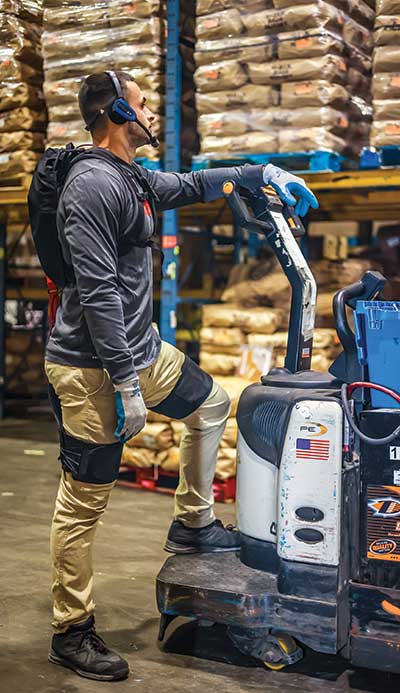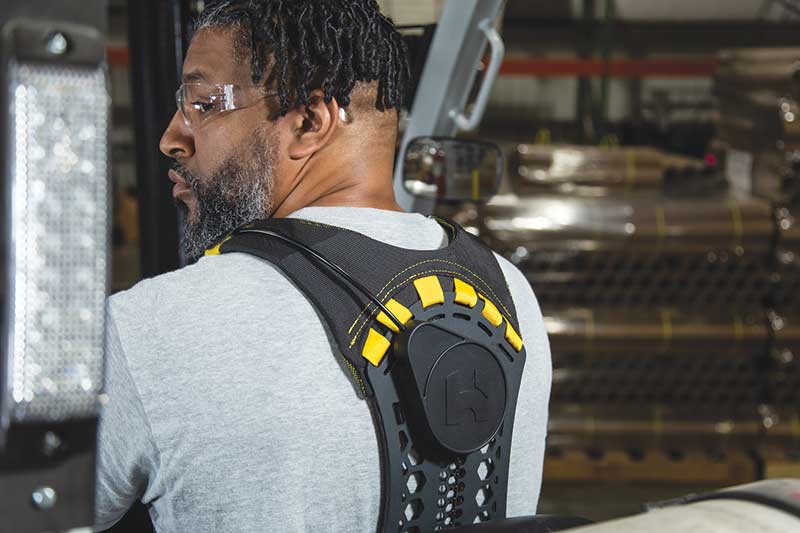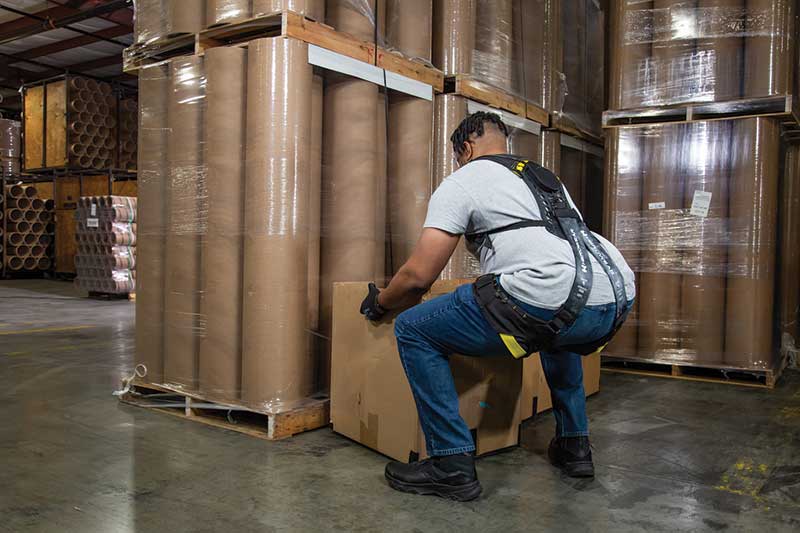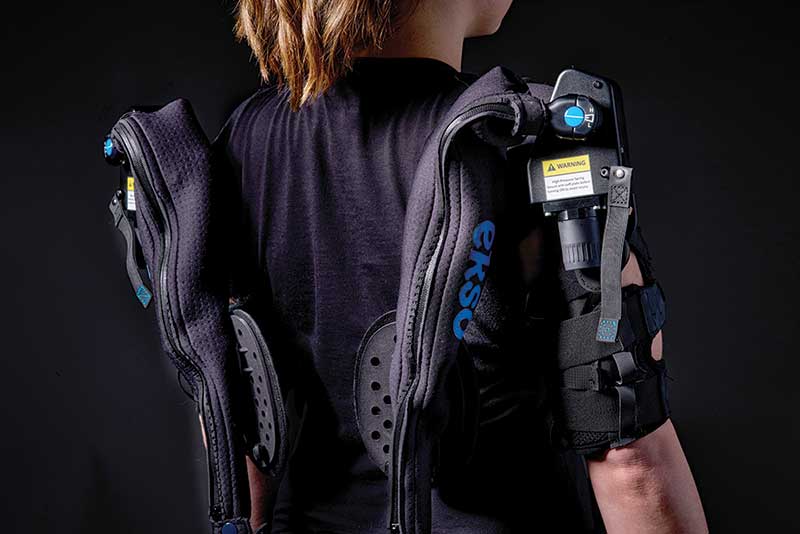The exoskeleton evolution
Today’s devices are more comfortable and user friendly than ever, but they’re still seeking widespread adoption.
As technology like ChatGPT and advanced augmented reality enter the room, tools like exoskeletons don’t feel all that futuristic any more. Yet they remain a nascent addition to materials handling. Originally designed for agricultural use long ago, and military use more recently, exoskeleton developers have devoted hours of engineering to bring them to the industrial world, helping in both manufacturing and warehousing.
While still a novel concept, some makers claim exoskeletons will one day soon be standard personal protective equipment (PPE).
There’s good reason to get behind the idea. In spite of tech layoffs, the nation continues to experience a debilitating labor shortage. According to a recent U.S. Chamber of Commerce report, the country has more than 10 million job openings but only 5.7 unemployed workers.
Within that segment, industries like manufacturing and warehousing remain some of the toughest jobs for recruiting qualified labor. It can be gritty, monotonous, hard-on-the-body work, and that’s become a tough sell—particularly with younger generations who are seeking positions that provide a more mental challenge.
Materials handling jobs also come loaded with repetition. “Think about lifting tens of pounds hundreds of times each hour, thousands of times in a day,” says Ilya Mirman, head of marketing and sales operations at Verve Motion. “Repeated strain on the back has a big impact on quality of life and also impacts the job someone can perform.”
Add in an aging and less physically fit workforce than in decades past, and the high cost of injuries/healthcare, employee turnover and lost productivity, and the ergonomic assist of exoskeletons begins to look attractive.
“Companies are seeing an increased value in their workers, instead of viewing them as disposable,” says Paul Nicholson, vice president of growth for HeroWear. “Back injuries and other ergonomic issues were viewed as par for the course. That’s no longer the case.”
Today’s devices
Exoskeletons are lightweight, external frames, backpacks or vests that can support and even enhance an employee’s tasks. In this capacity, they help stave off common injuries of the back, knees, shoulders and more. There are more than 100 manufacturers of the exoskeletons today, many of them based in Europe, where the devices are more widely adopted than in the United States. Of the many exoskeleton companies, about a dozen are making inroads to materials handling, more of those still in manufacturing versus warehousing.
Most exoskeleton designs fall into two main buckets: passive and active systems. A passive system is based off the concept that a set of springs or elastics store energy and return it during a common lift or movement. An active system is powered by batteries or sometimes even gas, and provides more assistance than its passive peer.
The active systems are often what you might picture an exoskeleton to be—a hard, rigid “skeleton” that mimics a body’s structure. Passive devices tend to be lighter and might resemble a backpack or a vest, but there can also be crossover between the two. Both have pros and cons to consider.
While a fairly straightforward concept, getting exoskeletons to a practical-to-use place was a bit hard to come by. The last decade or so finally brought about the evolution that was needed, however, to take them to a more widely adoptable version.

“Today’s exoskeletons don’t look dramatically different than their earliest designs from the 19th century,” says Nicholson. “What has taken them so long to become practical is that they’re tough to make comfortable for people to work in. Historically, they’ve always slowed people down.”
But that’s changing, with a focus on making lighter, more comfortable exoskeletons. “Material science finally caught up so that we could produce a device both strong enough and comfortable to wear,” Nicholson explains. “There’s a new crop of options out there designed with the user in mind.”
The more rigid, active systems provide more assist and are often deployed for tasks such as those that require holding your arms up overhead for long stretches of time—think a car manufacturing plant, for instance.
Such a design can cut down on back, shoulder and neck injuries. These systems can also play a role in heavy lifting tasks, assisting a user in bending, picking up and carrying a load from one location to another.
Smaller, more lighter weight devices like vests and backpacks have their roles, too. While not as heavy duty a skeleton, they can provide plenty of assistance to a worker as they go about repetitive tasks on a warehousing or manufacturing floor.
“Our backpacks can offload up to 40% of the load, and reduce the work required by muscles,” says Mirman. “The impact of this is dramatic, by a factor of up to 80% or 90%.”
Not only will workers be more productive wearing an exoskeleton, but by reducing injuries, a company can create a rather quick ROI, according to Anthony Pratt, vice president of sales at Ekso Bionics. “It all starts with worker safety,” Pratt says. “Exoskeletons reduce fatigue so that workers are using the right techniques for their environment. It’s a show of investing in your people.”
It also saves money in healthcare costs, high employee turnover, and lost productivity. Consider the fact that injuries and their healthcare expenses total $14 billion per year in the United States, and the average injury takes a worker out for 13 days, according to stats compiled by Verve Motion. Productivity is lost to a tune of 7% to 10%. According to Nicholson, when you offset such numbers with the purchase of an exoskeleton, you can expect an ROI in as quickly as six months.
Factors to consider
The important aspect to get right when it comes to an exoskeleton is comfort and wearability. Without it, you won’t have compliance and the suits will sit unused. Today’s options include softer materials and adjustable sizing, making them easier and more comfortable to wear.
“Ease of use is key,” says Pratt. “Every body is different, so we work with end users on site to measure and adjust to their particular sizing.”
This reflects a general movement in the exoskeleton industry to provide more individualized options, much like other types of PPE. Nicholson says HeroWear’s options take about 5 minutes to fit to the user. “We don’t go by small, medium and large, but have a modular design for each body part instead,” he explains. “We then dial in the right level of assist for each person to maximize their performance.”

All told, after about a week, most employees will have worked through some adjustments, trial and error, and have found the sweet spot. “After that, they never look back,” says Nicholson.
If an employee leaves the company, exoskeleton makers can return and remeasure/refit the exoskeleton for his or her replacement. “We go on site and remeasure the platform for the new end user,” says Pratt. Right now, you can expect an average exoskeleton to last about four or five years, he adds, even over the span of multiple users.
Maintaining exoskeletons requires a few simple steps: At the end of a shift, workers should spray them down with some sort of disinfecting solution and hang them up to dry overnight.
Nicholson says the idea is not to share them from one worker to the next, but to provide them as PPE to employees who want them. HeroWear just announced an updated version of its suits that makes most parts machine washable, too, making maintenance that much easier. “We also recommend a weekly checklist to make sure they are operational and in good shape,” he says.

Looking ahead
Right now, exoskeleton adoption remains in its early stages, says Bryan Jensen, chairperson and executive vice president at consultant firm St. Onge Company. “Exoskeletons are doing some great work,” he says, “and adoption of passive suits is moderately prevalent.”
Still, the United States remains behind its European counterparts in getting on board with the devices. “Exoskeletons are not being embraced as they could be here,” Jensen says. “In Europe, the governments are more protective of their employees, so they’re ahead of the curve.”
To determine if exoskeletons are right for your operations, Jensen recommends considering the cost of a back injury versus your investment in an exoskeleton.
“If you’re avoiding three to four back injuries, you’re paying back that investment,” he says. “But doing a comparative analysis can be hard, because it’s conditional. How do you know if you’ve avoided a back injury?”
Jensen adds that in many warehouses, companies still haven’t embraced a $50 back belt, so getting buy in for a far more expensive exoskeleton—often in the tens of thousands of dollars—can sometimes be a hard sell.
From Pratt’s vantage point, however, watching a worker experience the assist from an exoskeleton for the first time should be enough to solidify their adoption. “When people put it on for the first time and feel their pain go away, you can see it in their faces,” Pratt adds. “The product works.”











